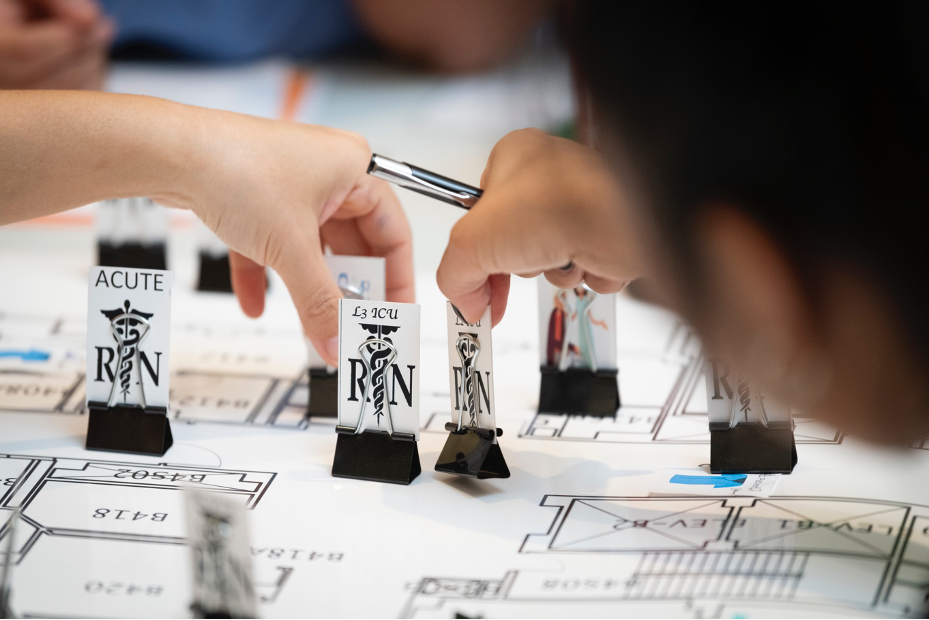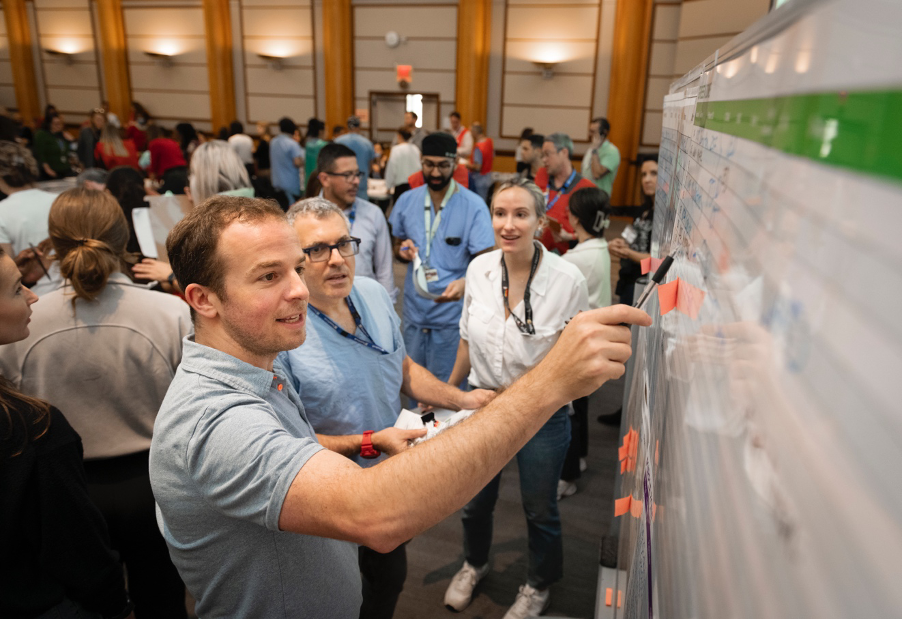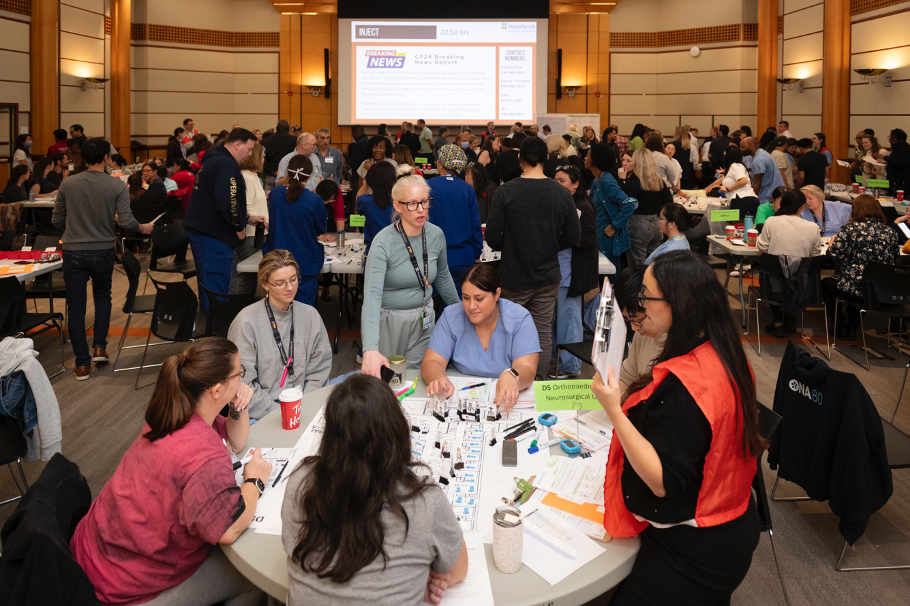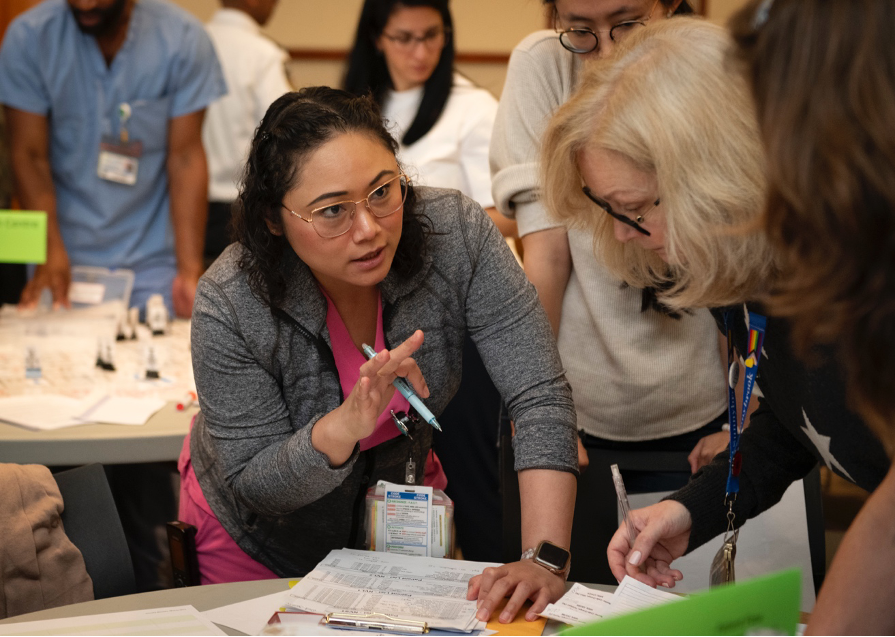Preparing for the worst: Inside Sunnybrook’s mock Code Orange exercise
It's a cold November evening in Toronto when disaster strikes. Reports of a loud bang, smoke and fire at a large downtown gathering start pouring in, and Sunnybrook Health Sciences Centre readies itself to receive an influx of patients from the scene. A Code Orange is called.
The teams that jump into action are real, but the event, thankfully, is not.
This scenario was part of a Code Orange tabletop exercise recently held to test and refine Sunnybrook’s response to a real mass casualty event. The exercise brought together interdisciplinary teams from across the hospital, alongside first responders, observers and participants from the Ontario government to assess the hospital's preparedness for a massive emergency.
Responding to an emergency rush of patients is not new to Sunnybrook. In 2018 the hospital played a critical role in responding to the Yonge Street van attack. It is in times like these, where Sunnybrook’s ability to quickly mobilize resources to support patients in a time of crisis, matters most.
What is a Code Orange tabletop exercise?
During the Code Orange tabletop exercise, Sunnybrook staff used hospital floorplans and movable pieces representing staff, patients and equipment - similar to a board game - to simulate responses to a mass casualty disaster scenario. Their task was to strategize in real-time how units or departments would respond to the real event. Identifying how to best triage patients, where staff are located and how resources are allocated are some of the complex task’s teams must work through.
This year’s mock exercise was essential to evaluate Sunnybrook’s ability to manage a surge in burn injuries and make sure Emergency Department (ED) staff were familiar with Emergency Medical Services (EMS) field triage tags. It also helped make sure staff understood disaster triage processes and that they had the opportunity to trial two new Code Orange communications tools.

Sunnybrook staff using the movable pieces on the game board during the mock exercise.
Teams like Patient Flow, Trauma, Surgery and members from the ED worked quickly during the exercise to assess the severity of the incident, determine where stable patients would be relocated to accommodate incoming injuries, and call in off-duty staff to support.
“These mock exercises are critical for our teams. Even though we hope disasters like these never happen, we always need to be prepared for the worst,” says Corey Freedman, Sunnybrook trauma services manager. "From a trauma perspective, it's really about working through our procedures to make sure we mobilize support as quickly as possible."
Teams were also given 'injects' throughout the exercise. Injects are new situations, complications, or issues 'injected' into the scenario that might require quick pivots or new responses. These included additional complications at the scene, technology failures and unexpected media coverage – all designed to challenge a team's response capabilities in the moment.
"Injects are a critical part of how we prepare for an actual Code Orange event because they allow us to collect data on how teams would respond to various situations that might arise during a real response,” says Jayme Paterson, an emergency preparedness specialist at Sunnybrook. "We use input from all major units across the hospital to create injects based on real-life situations our teams have encountered, or could encounter."
An all-hands-on-deck approach
At the core of the exercise, is the idea that responding to a Code Orange is not simply the responsibility of ED staff or trauma doctors. It’s an all-hands-on-deck situation requiring many interdisciplinary teams to work together to ensure the best possible outcome.

Two trauma team leaders and a trauma surgeon discuss incoming causalities on the Emergency Department tracking board.
Everyone from frontline staff to senior leaders participated in the mock Code Orange tabletop exercise. Participating teams included clinical departments like the ED, labs, blood banks, ORs and Intensive Care Units. It also included non-clinical departments that play a crucial role in supporting the response, such as Strategic Communications, Patient Flow, Security, Patient Transport, Infection Prevention and Control, and Environmental Services.
What sets Sunnybrook’s approach apart?
Sunnybrook's approach blends principles from traditional board game-style exercises and scenario-based exercises to develop what Paterson calls a “functional tabletop exercise.” This functional approach, she says, uses principles of adult learning and immersive gaming to design an exercise that provides the most learning opportunities and benefits to all participants.
“This approach really allows teams to visualize and act-out what a Code Orange may look like in real-life, rather than simply discussing it.”

Staff from the Orthopedic and Neurosurgical Unit strategize their unit’s approach to a Code Orange. Critical Care Unit staff working through the mock exercise.
No two mock exercises are ever the same at Sunnybrook. Developers of the exercise make sure scenarios are adapted year over year to reflect the variety of complex disasters that could occur in a city like Toronto, like an explosion at a shopping mall or car pile-up on a major highway. This allows Sunnybrook’s emergency preparedness teams to evaluate its response to any given disaster and learn from previous experiences.
Why it matters
These types of exercises help validate corporate and departmental Code Orange plans and policies to advance the overall readiness for a real Code Orange. They also allow staff to test plans and policies while also identifying any gaps and challenges, so they’re always prepared for the real thing.
The table top exercises also support individual and organization learning, where staff, leaders and community partners can work through challenges and make sure a thorough Code Orange protocol is always in place.

Staff from the Orthopedic and Neurosurgical Unit strategize their unit’s approach to a Code Orange. Critical Care Unit staff working through the mock exercise.
What happens next?
Disaster can strike at any moment and is often unpredictable. Emergency preparedness and the ability to receive patients involved in a mass casualty event is an integral part of Sunnybrook’s duty of care as a health systems leader and Level 1 trauma centre.
Following the exercise, teams participate in a ‘hot debrief’ where they share successes, challenges and questions they encountered. The debrief feedback is then shared with the Code Orange Steering Committee to inform future exercises, as well as processes and procedures for a real Code Orange.
The feedback is used to create the After-Action Report, which contains actionable outcomes for various departments. This report helps shape the hospital’s Code Orange response, making sure Sunnybrook is always ready when disaster strikes.






